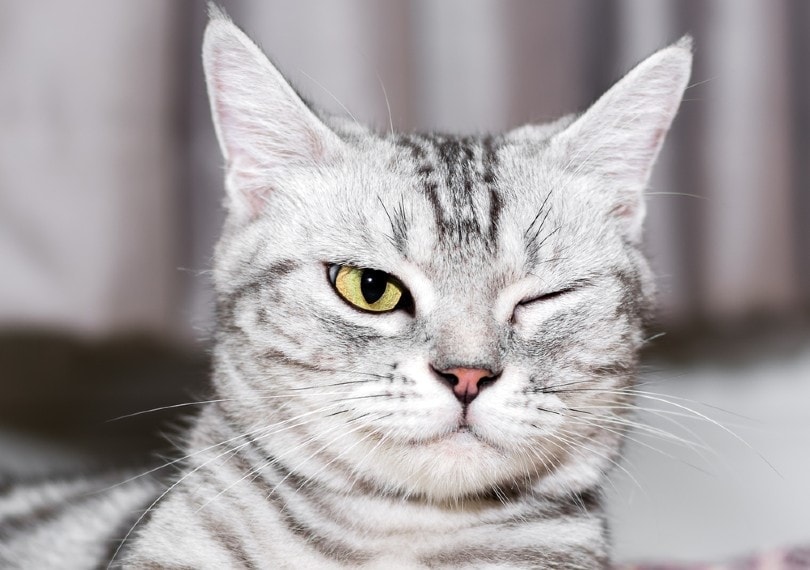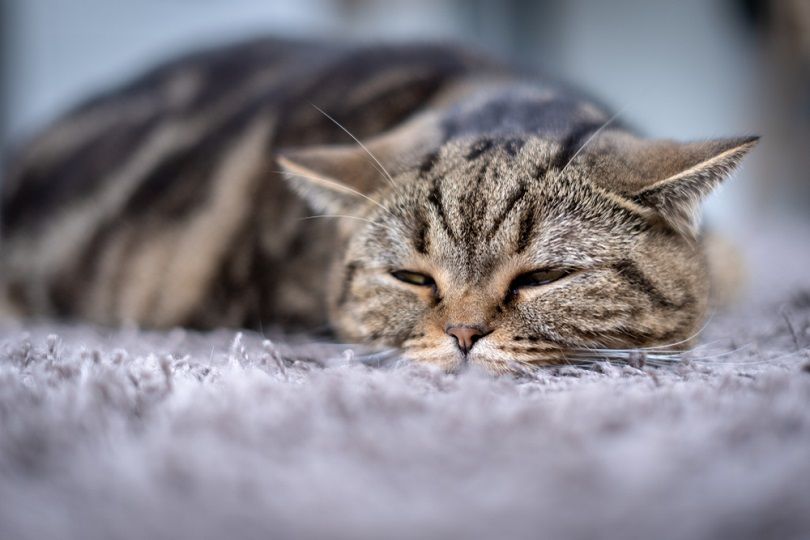Why Do Cats Have Eye Boogers? Vet-Verified Reasons & Precautions
Updated on

They say the eyes are the windows to the soul, but what happens when the windows spring a leak? If your cat’s eyes are suddenly crusted with boogers, you’re probably wondering what’s going on and if you should be worried.
Cat eye discharge can occur for several reasons, whether it be a sign of certain ailments or the morphology of your cat’s eyes. In this article, we’ll cover some of the most common causes of cat eye boogers and what you should do about them.
Causes of Cat Eye Discharge
1. Eye Infections
If your cat’s eye boogers are accompanied by mildly swollen or red eyes, they could be a sign of infectious conjunctivitis or an eye infection. Other signs of this condition, but not exclusive to it, include squinting or excessive blinking of one or both eyes.
Infectious conjunctivitis is one of the most common eye problems in cats. It usually occurs in cats due to feline herpesvirus infection (FHV-1) but also calicivirus and bacteria such as Chlamydophila felis. Treatment usually involves administering eye drops or ointment and sometimes oral medication as well, depending on the underlying cause of conjunctivitis.
2. Eyelash Abnormalities
Your cat may have an eyelash abnormality that results in an excessive amount of ocular discharge. These include:
- Distichiasis (extra eyelashes arising from eyelid glands
- Ectopic cilia (single hair growing on the inside of the eyelid)

3. Corneal Ulcer
Corneal ulcers, or injuries to the surface of your cat’s eye, are another common reason for eye discharge. Ulcers can have many causes, including injuries from fighting or playing, rubbing of the eye, chemical irritation, or eyelid abnormalities. Other signs of corneal ulcers include squinting, pawing at the eye, and keeping the eyes closed.
This eye condition is extremely painful and can quickly become worse if not treated. Generally, treatment involves eye medication, pain medication, and often anti-inflammatory medication. The cat must be prevented from causing additional injury to the eye, usually by wearing an e-collar or “cone”. Depending on the severity of the ulcer, your vet may recommend surgery to repair the damage.
4. Upper Respiratory Infection
Most upper respiratory infections are caused by a virus, such as feline herpesvirus. They are extremely infectious and spread quickly among large colonies of cats, such as those in shelters or catteries. Your vet will formulate a treatment plan for your cat based on their age, vaccination status, and the severity of the signs they have.

5. Eyelid Abnormalities
There is one specific eyelid conditions can cause eye discharge in your cat. Entropion is when the cat’s eyelid rolls inward, allowing the eyelashes to contact the surface of the eye. The resulting irritation can cause eye discharge or lead to more serious conditions, like corneal ulcers.
Treatment of this condition may involve surgery, temporary sutures, or medications, depending on how severe it is.
Lagophthalmos is the inability of completely closing the eyelids. This often results in your cat’s eye drying and trauma to their cornea. It is common in breeds with a short, broad, flat head (such as Persians). For such cats, long-term use of lubricating ointments is the preferred management option. Occasionally, their eyelids may be surgically modified to shorten or close the corners of the eyes to allow for complete closure of the lids whenever your cat needs to close their eyes.
Kittens may sometimes be born with a deformity of the upper eyelids known as coloboma. This appears as an opening (also known as a cleft) in the upper eyelid. The defective eyelid is often unable to function properly, increasing the likelihood of infections, inflammations, and ulcers. Treatment for this condition is a surgical repair.
6. Uveitis
Uveitis is a condition where the uvea of the cat’s eyes become inflamed. The uvea is the vascular layer in the inside of the eye. Uveitis often implies that the anterior or “front” portion of the uvea is inflamed. Eye discharge is a common sign of uveitis, along with squinting, cloudiness, abnormal pupil shape, impaired vision, and red eyes.
Uveitis in cats is usually caused by viral diseases such as Feline Leukemia Virus (FeLV), Feline Immunodeficiency Virus (FIV), Feline Infectious Peritonitis (FIP), or other infectious diseases. Though some of these underlying causes, especially the viral diseases, can never be fully treated, uveitis requires immediate veterinary care and should be treated as an emergency. Left untreated, the condition can quickly result in cataracts, glaucoma, or permanent vision loss (blindness). The underlying causes should be managed based on treatment plans set by your veterinarian.

7. Glaucoma
Glaucoma is an elevation in the pressure inside one or both of your cat’s eyes. The condition is painful and may sometimes set in as a result of other ocular issues (such as uveitis). Eye discharge is one sign of this condition, along with squinting, bulging eyes, and impaired vision.
8. Dry Eye
The eye often improves when the underlying cause is addressed and treated. Until then, extra lubrication in the form of eye drops or a lubricating ointment is often prescribed. In cases where dry eye has no treatable underlying cause, your cat would need lifelong assistance with eye medication or lubricating ointments to manage the dryness.

While many abnormalities of the eye will inevitably lead to excessive discharge and a buildup of boogers in your cat’s eyes, it is important to note that, just like us, cats will naturally get some eye boogers along the inner corner of their eye, especially when they’ve been sleeping for a while. However, you should still observe them for a sudden increase in the discharge, a foul-smelling discharge, or the other signs listed with each condition, such as pawing at the eye, squinting, your cat appearing in pain or discomfort, or one eye appearing different.
How to Handle Your Cat’s Eye Boogers
As we’ve learned, eye boogers may have many different causes. The first step in dealing with them is to understand why they are occurring. Many eye conditions are extremely painful and potentially blinding, and are considered emergencies.
Especially if you notice signs of pain in your cat, such as squinting or pawing at the eye, you should see your veterinarian as soon as possible. Sometimes, your vet may refer you to a veterinary ophthalmologist to manage your cat’s eye condition. Always be sure to give all medications and follow all directions from your vet to treat your cat’s eyes.
If you’re concerned about giving your cat eye medications, ask your vet or their staff to teach you their tips and tricks. Often, you’ll need to learn how to clean the eye boogers from your cat’s eyes, generally with warm water and gauze or a soft cloth.
Conclusion
Cat eye boogers may make some people squeamish, but they also aren’t something you can ignore or wipe away. Our cats are masters at hiding the seriousness of illnesses or injuries, and it’s up to us to pay attention to what signs they do show. Eye discharge may seem like nothing but a nuisance, but it could be just the only visual evidence of a threat to your cat’s vision and well-being.
See also:
- Conjunctivitis In Cats: Vet-Approved Causes, Signs & Treatments
- Do Cats Like Baby Talk? What Experts Say
Featured Image Credit: osobystist, Shutterstock













